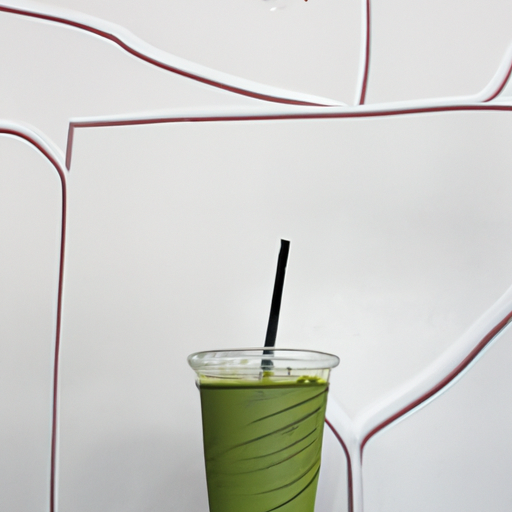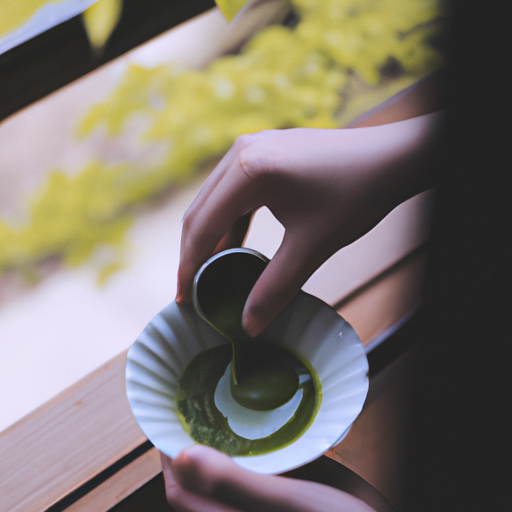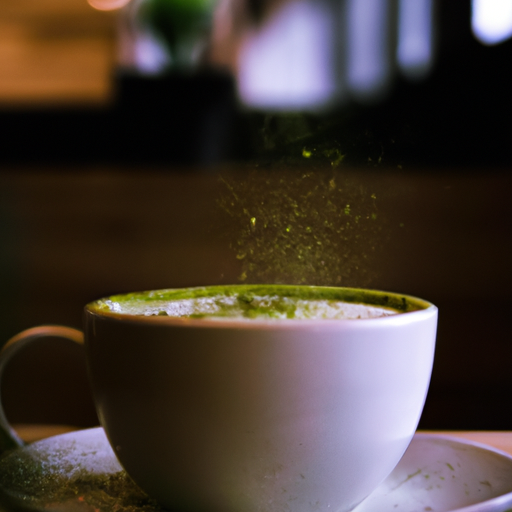There’s a lot of buzz around matcha. Some describe its flavor as bitter, while others suggest it has a sweet, earthy profile. Having never sampled matcha myself, I’m intrigued about its true taste. Does it live up to its reputation, or is it merely a fashionable beverage that’s currently in vogue?
To find out, I delved into the history and origins of matcha, as well as the growing, harvesting, and grinding process of the tea leaves. I also discovered the importance of shade-grown matcha leaves and how it affects the taste of the final product.
After learning about the traditional Japanese tea ceremony and the health benefits of matcha, I was excited to finally try it for myself and see what all the fuss was about.
Key Takeaways
- Matcha has a vegetal taste that’s complemented by umami and subtle sweet notes.
- The umami taste is a result of the amino acids that are produced during the shading process.
- Some may compare matcha’s taste to that of grass or seaweed.
- Bitterness and astringency contribute to matcha’s unique flavor and health benefits.
Brief History and Origins of Matcha Tea
The origins of matcha tea can be traced back to 12th century Japan, where it was first used in traditional tea ceremonies. Matcha tea is made from shade-grown tea leaves, which are carefully harvested and processed to produce a fine powder.
The cultivation techniques used to grow matcha tea are unique to Japan and have been passed down through generations of tea farmers. The cultivation of matcha tea involves covering the tea plants with shade cloths for several weeks before harvesting. This process helps to increase the chlorophyll content of the leaves, giving them a vibrant green color and a unique flavor.
After the leaves are harvested, they are steamed, dried, and sorted to remove any impurities. The leaves are then ground into a fine powder using traditional stone mills. The growing and harvesting process of matcha leaves is a time-consuming and labor-intensive process, but it is essential to producing the high-quality tea that matcha is known for.
The unique cultivation techniques and processing methods used to produce matcha tea have been refined over centuries, resulting in a tea that is prized for its rich flavor, vibrant green color, and health benefits.
The Growing and Harvesting Process of Matcha Leaves
As farmers cultivate and pick the leaves, the flavor and quality of matcha are influenced by various factors. Growing techniques play a crucial role in determining the taste and aroma of matcha. The best matcha leaves are grown in areas with nutrient-rich soil, and farmers employ sustainable practices such as crop rotation and natural fertilizers to ensure that the soil stays healthy.
To produce high-quality matcha, farmers use a shading technique known as tana. Tana involves covering the tea plants with a shade cloth to reduce the amount of sunlight they receive. This technique slows down the growth of the leaves and increases the production of chlorophyll, resulting in a darker green color and richer flavor. Farmers must carefully monitor the shading process to ensure that the leaves do not develop too quickly or too slowly.
Harvesting matcha leaves is a delicate process that requires precision and skill. Farmers typically hand-pick the leaves to ensure that only the youngest, most tender leaves are used. These leaves are then steamed to prevent oxidation and dried before being ground into a fine powder. The resulting matcha has a uniquely complex flavor that is both sweet and bitter, with a hint of umami.
As we move on to the next section, it’s important to note the significance of the shading process in creating the distinctive taste of matcha.
The Importance of Shade-Grown Matcha Leaves
By using the tana shading technique and harvesting only the youngest leaves, matcha farmers are able to produce a powder with a uniquely complex flavor profile. Shade-grown matcha leaves have a distinct advantage over sun-grown ones as the shading process increases the chlorophyll and amino acid content in the leaves, resulting in a richer and more nuanced taste. The shade-grown benefits are numerous, and matcha enthusiasts swear by the resulting taste.
To fully appreciate the flavor complexity of matcha, it is essential to understand the role of shading in its production. The shading process is critical as it allows the leaves to develop higher levels of L-theanine, which is responsible for the rich umami taste and the sweetness that is unique to matcha. The shading process also reduces the bitterness of the tea, ensuring a balanced and harmonious flavor. The resulting matcha powder is a symphony of flavors that leaves a lasting impression on the palate.
The importance of shade-grown matcha leaves cannot be overstated. The unique flavor profile of matcha is a result of the shading process and the careful harvesting of the youngest leaves. The resulting powder is a testament to the skill and dedication of matcha farmers. In the next section, we will explore the grinding process of matcha leaves into powder, which is the final step in the production of this beloved tea.
The Grinding Process of Matcha Leaves into Powder
Now it’s time for you to experience the magic of matcha as you witness the grinding process of the shade-grown leaves into a fine, vibrant green powder.
The grinding process, also known as tencha, is the most crucial step in producing matcha. The leaves are carefully selected, steamed, dried, and then ground using traditional granite stone mills. The grinding process of matcha leaves is a painstakingly slow process that requires a lot of skill and patience.
It can take up to an hour to grind just 30 grams of matcha powder. The result of this process is a fine, silky smooth powder that is incredibly versatile and can be used in a variety of ways. The flavor profile of matcha tea is complex and nuanced.
It has a vegetal taste that is both sweet and bitter, with a slightly astringent finish. The taste of matcha is often described as earthy, umami, and slightly nutty. This unique flavor profile is what sets matcha apart from other teas and makes it a favorite among tea enthusiasts.
Taste Profile of Matcha Tea
As I take a sip of my freshly whisked matcha tea, the first thing that strikes me is the vegetal taste with umami and sweet notes. It’s a unique flavor profile that can be compared to grass or seaweed, but with a deeper, more complex taste.
However, there is also a slight bitterness and astringency that lingers on the tongue, which some may find off-putting but others may enjoy as a balance to the sweetness.
Overall, the taste of matcha tea is an acquired taste that requires an appreciation for its subtle nuances.
Vegetal Taste with Umami and Sweet Notes
When you take a sip of matcha, you’ll experience a unique vegetal flavor that’s complemented by umami and subtle sweet notes. The vegetal taste comes from the chlorophyll that’s present in the tea leaves, while the umami taste is a result of the amino acids that are produced during the shading process. The sweetness, on the other hand, is a natural characteristic of the tea leaves, which are grown in a specific way to ensure that they are rich in flavor.
To better understand the taste profile of matcha, take a look at this table:
| Flavor | Description | Pairing Suggestions |
|---|---|---|
| Vegetal | Fresh, grassy taste | Sushi, light fish dishes |
| Umami | Savory, brothy taste | Ramen, miso soup |
| Sweet | Subtle sweetness | Pastries, fruits |
As you can see, matcha is a versatile tea that can be paired with a wide range of foods. The vegetal taste makes it a great match for sushi and light fish dishes, while the umami taste pairs well with heartier dishes like ramen and miso soup. And if you’re looking for a sweet treat, matcha’s subtle sweetness makes it a great complement to pastries and fruits.
While some may compare matcha’s taste to that of grass or seaweed, it’s important to note that the unique blend of flavors and notes in matcha tea make it a one-of-a-kind experience.
Comparisons to Grass or Seaweed
Imagine yourself sipping on a cup of matcha and experiencing a unique blend of flavors. Some may compare it to the taste of grass or seaweed. Matcha has a vegetal taste that can be described as earthy and slightly bitter with a distinct umami flavor. However, the grassy or seaweed taste is not overpowering and is balanced with sweet notes that make it a pleasant experience.
The grassy vs. seaweed taste is subjective and depends on personal preferences. Some may find the grassy taste more prominent, while others may lean towards the seaweed taste. However, the culinary applications of matcha go beyond just drinking it as tea. Matcha can be used as an ingredient in various recipes like smoothies, desserts, and even savory dishes. Incorporating matcha into recipes can help balance out the grassy or seaweed taste and bring out the sweetness and umami flavors.
As matcha is known for its unique flavor profile, it’s essential to understand the taste before incorporating it into recipes. Moving onto the next section, we’ll explore the bitterness and astringency of matcha and how it affects its overall taste.
Bitterness and Astringency
You may notice a bitter and astringent taste in matcha, which can be attributed to the high levels of catechins and caffeine present in the tea. However, this flavor profile is not necessarily a bad thing. In fact, it’s what makes matcha unique and contributes to its health benefits.
To balance out the bitterness and astringency, matcha is often paired with sweet flavors, such as honey or fruit. Additionally, the preparation method can greatly affect the taste. Higher quality matcha is typically smoother with a sweeter taste, while lower quality matcha may have a harsher, more bitter taste.
Despite the initial bitter taste, the health implications of matcha make it a popular choice for many tea drinkers.
Moving on to factors that affect the taste of matcha, the quality of the tea leaves and the preparation method are key components that can greatly impact the final taste.
Factors that Affect the Taste of Matcha
To fully appreciate the taste of matcha, it’s essential to understand the factors that affect its flavor. One of the most significant factors is the quality of the tea leaves used. Matcha made from high-quality, shade-grown tea leaves tends to have a sweeter, richer taste than matcha made from lower-grade tea leaves.
Additionally, the method of grinding the tea leaves also plays a significant role in the flavor. Matcha that has been stone-ground has a smoother, creamier taste than matcha that has been machine-ground.
Another factor that affects the taste of matcha is the water temperature used to prepare it. Matcha is traditionally prepared with water that is around 175°F, which helps to release the tea’s full flavor without making it bitter or astringent. However, some people prefer to use water that is slightly cooler or warmer, depending on their personal taste preferences. The water quality can also impact the flavor of matcha, with soft water being preferred over hard water.
Lastly, the way matcha is prepared and served can also affect its taste. For example, matcha that has been whisked vigorously and served in a traditional chawan (tea bowl) tends to have a frothy texture and a more complex flavor profile than matcha that has been prepared with less care and served in a regular cup. Serving matcha with traditional Japanese sweets, such as wagashi, can also enhance its flavor by providing a contrast between sweet and bitter tastes.
Understanding the factors that affect the taste of matcha can help you appreciate its unique flavor profile. Next, we’ll explore the traditional Japanese tea ceremony and how matcha is an integral part of this cultural practice.
Traditional Japanese Tea Ceremony and Matcha
As I step into the serene and elegant tatami room, the aroma of freshly whisked matcha fills my senses, signaling the start of a traditional Japanese tea ceremony.
The Japanese culture places a significant emphasis on the tea ceremony, which is considered a form of art that requires meticulous attention to detail and tea ceremony etiquette. The ceremony is a timeless practice that has been passed down from generation to generation, and it’s a way of preserving the rich cultural heritage of Japan.
The tea ceremony involves several steps, including the preparation of the tea, the presentation of the tea bowl, and the drinking of the tea. The host of the ceremony carefully follows the tea ceremony etiquette, which involves specific movements and gestures that are meant to show respect and appreciation for the guests.
The tea bowl is presented to the guest with the most beautiful side facing him or her, and the guest is expected to admire the bowl before drinking the tea.
As I take a sip of the freshly whisked matcha, I’m struck by the complex and nuanced taste. The bitterness of the tea is balanced by a delicate sweetness, and the umami flavor adds a rich depth to the taste. The tea is both refreshing and soothing, and it leaves a pleasant aftertaste in my mouth.
The health benefits of matcha tea are numerous, and I look forward to exploring them in the next section.
Health Benefits of Matcha Tea
Many medical experts maintain that consuming matcha tea can promote overall wellness and weight loss. Matcha is packed with antioxidants called catechins, which are known for their anti-inflammatory and anti-cancer properties. Additionally, matcha is high in L-theanine, an amino acid that promotes relaxation and reduces stress.
In terms of flavor profile, matcha has a unique taste that is both vegetal and slightly bitter. Some people describe it as grassy or earthy, while others find it refreshing and energizing. Matcha can be enjoyed on its own or mixed with other ingredients to create delicious and healthy beverages like matcha lattes, smoothies, and shakes.
Overall, the health benefits and flavor profile of matcha make it a popular choice for those looking to improve their overall health and wellness. In the next section, we will explore the culinary uses of matcha powder and how it can be incorporated into various dishes to add flavor and nutrition.
Culinary Uses of Matcha Powder
You might be surprised at the versatility of matcha powder in the kitchen, as it can be used to add a unique and healthy twist to a variety of dishes and drinks.
One popular way to incorporate matcha powder into your culinary creations is by using it in desserts. Matcha desserts have become increasingly popular over the years, with matcha-infused cakes, cookies, and ice creams being just a few examples. The earthy, slightly bitter taste of matcha pairs exceptionally well with sweet flavors, making it the perfect ingredient to add depth of flavor to your favorite desserts.
Another way to use matcha powder in cooking is by adding it to latte recipes. Matcha lattes have become a trendy alternative to traditional coffee lattes, and for good reason. The combination of matcha powder, milk, and sweetener creates a creamy, frothy drink that is both energizing and calming. Matcha lattes are also a healthier alternative to coffee lattes, as they contain antioxidants and other nutrients that provide a boost of energy without the caffeine crash.
Overall, matcha powder is a versatile ingredient that can be used in a variety of culinary creations. Whether you’re looking to add a healthy twist to your favorite dessert or create a trendy matcha latte, this vibrant green powder is sure to impress.
So, next time you’re in the kitchen, don’t be afraid to experiment with matcha powder and see what delicious creations you can come up with.
Frequently Asked Questions
What is the caffeine content in matcha compared to other types of tea?
When it comes to caffeine content, matcha surpasses other types of tea by a long shot. One cup of matcha contains about 70 milligrams of caffeine, which is significantly higher than the 30-50 milligrams found in a cup of black tea or the 15-30 milligrams in a cup of green tea.
This makes matcha a great alternative to coffee for those looking for an energy boost without the jitters. Additionally, matcha has numerous health benefits, such as being rich in antioxidants, aiding in weight loss, and boosting brain function.
As for the best time to drink matcha tea, it’s recommended to consume it in the morning or early afternoon to avoid disrupting your sleep cycle.
Overall, incorporating matcha into your daily routine can provide a plethora of benefits for both your physical and mental health.
Can matcha be used in baking and cooking recipes?
Matcha has become a popular ingredient in baking and cooking recipes due to its unique flavor profile. It has a slightly bitter and earthy taste, with a subtle sweetness and a smooth texture.
When used in recipes such as cakes, cookies, and ice cream, matcha adds a distinct green hue and a delicate flavor that pairs well with other ingredients. It can also be used in savory dishes such as sauces, dressings, and marinades, adding a depth of flavor and complexity to the dish.
Overall, matcha recipes offer a unique and flavorful twist to traditional recipes, making them a fun and exciting way to experiment in the kitchen.
What is the difference between ceremonial grade and culinary grade matcha?
When it comes to matcha, there are two main grades to consider: ceremonial and culinary. While some may argue that ceremonial grade is the only way to go, I’d argue that it really depends on your intended use.
If you’re looking to make traditional matcha tea, then ceremonial grade is definitely the way to go. It’s made from the youngest tea leaves, which are shaded before being harvested, resulting in a sweeter, more delicate flavor. Ceremonial grade has a sweet, vegetal flavor with hints of umami.
On the other hand, if you’re planning on using matcha in baking or cooking recipes, then culinary grade is a better choice. It’s made from slightly older tea leaves and has a stronger, more robust flavor that stands up well to other ingredients. Culinary grade has a stronger, more bitter taste with a slightly astringent finish.
Regardless of which grade you choose, both offer unique tasting notes that distinguish them from each other and other types of tea. Ultimately, it’s up to personal preference and intended use when deciding which grade of matcha to choose.
How does the age of matcha leaves affect their taste?
When it comes to matcha, the age of the leaves can significantly affect its taste. Matcha leaf grades, as well as harvesting techniques, influence the overall quality of the tea.
For instance, younger leaves tend to produce a sweeter and more delicate flavor profile, while older leaves can result in a more robust, bitter taste. Additionally, the way in which the leaves are picked and processed can also impact the final taste of the matcha.
Overall, the age of the matcha leaves is just one of many factors that contribute to the complexity and uniqueness of this beloved Japanese tea.
Is matcha tea suitable for people with dietary restrictions such as gluten-free or vegan diets?
As someone who follows a gluten-free and vegan diet, I can attest that matcha tea is definitely suitable for those with dietary restrictions. There are many gluten-free alternatives to traditional wheat-based products that can be used to make matcha treats, such as almond flour or coconut flour.
Additionally, there are countless vegan recipes out there for matcha lattes, smoothies, and even desserts that don’t rely on dairy or animal products. Matcha itself is naturally gluten-free and vegan, so as long as you stick to using compatible ingredients in your recipes, you can enjoy this delicious tea without any worries.
Conclusion
In conclusion, I must say that matcha tea is an acquired taste. It has a unique flavor profile that can be described as earthy, grassy, and slightly bitter. However, the taste can vary depending on the quality of the tea leaves, the growing conditions, and the preparation method. As someone who’s tried matcha tea, I can say it’s not for everyone. But for those who appreciate the subtle nuances of flavor and the cultural significance of matcha, it’s a beverage worth exploring.
Moreover, matcha tea isn’t just a beverage, it’s a way of life. The traditional Japanese tea ceremony, which revolves around the preparation and consumption of matcha, is a testament to the cultural significance of this drink. Additionally, matcha tea has numerous health benefits, including boosting metabolism, improving mental clarity, and providing antioxidants.
Finally, the culinary uses of matcha powder are extensive, ranging from smoothies and baked goods to savory dishes. Overall, matcha tea is a versatile and complex beverage that deserves to be explored and appreciated.










